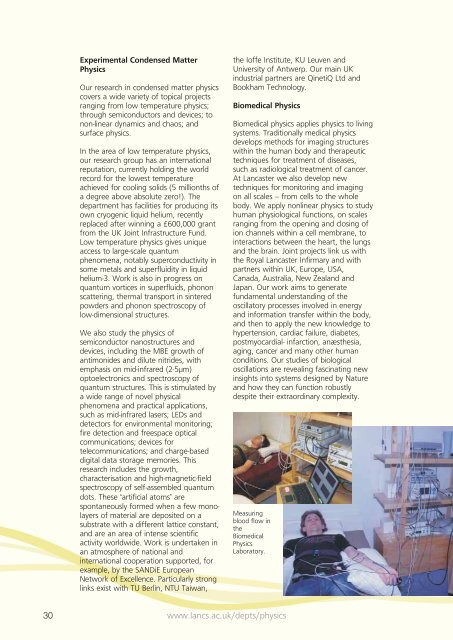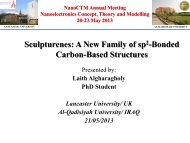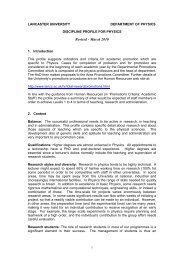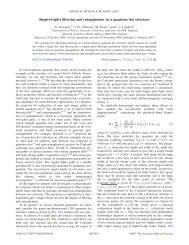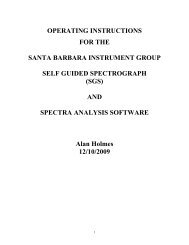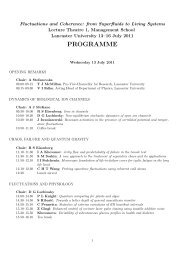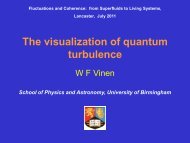Theoretical Physics - Physics at Lancaster University
Theoretical Physics - Physics at Lancaster University
Theoretical Physics - Physics at Lancaster University
Create successful ePaper yourself
Turn your PDF publications into a flip-book with our unique Google optimized e-Paper software.
Experimental Condensed M<strong>at</strong>ter<br />
<strong>Physics</strong><br />
Our research in condensed m<strong>at</strong>ter physics<br />
covers a wide variety of topical projects<br />
ranging from low temper<strong>at</strong>ure physics;<br />
through semiconductors and devices; to<br />
non-linear dynamics and chaos; and<br />
surface physics.<br />
In the area of low temper<strong>at</strong>ure physics,<br />
our research group has an intern<strong>at</strong>ional<br />
reput<strong>at</strong>ion, currently holding the world<br />
record for the lowest temper<strong>at</strong>ure<br />
achieved for cooling solids (5 millionths of<br />
a degree above absolute zero!). The<br />
department has facilities for producing its<br />
own cryogenic liquid helium, recently<br />
replaced after winning a £600,000 grant<br />
from the UK Joint Infrastructure Fund.<br />
Low temper<strong>at</strong>ure physics gives unique<br />
access to large-scale quantum<br />
phenomena, notably superconductivity in<br />
some metals and superfluidity in liquid<br />
helium-3. Work is also in progress on<br />
quantum vortices in superfluids, phonon<br />
sc<strong>at</strong>tering, thermal transport in sintered<br />
powders and phonon spectroscopy of<br />
low-dimensional structures.<br />
We also study the physics of<br />
semiconductor nanostructures and<br />
devices, including the MBE growth of<br />
antimonides and dilute nitrides, with<br />
emphasis on mid-infrared (2-5μm)<br />
optoelectronics and spectroscopy of<br />
quantum structures. This is stimul<strong>at</strong>ed by<br />
a wide range of novel physical<br />
phenomena and practical applic<strong>at</strong>ions,<br />
such as mid-infrared lasers; LEDs and<br />
detectors for environmental monitoring;<br />
fire detection and freespace optical<br />
communic<strong>at</strong>ions; devices for<br />
telecommunic<strong>at</strong>ions; and charge-based<br />
digital d<strong>at</strong>a storage memories. This<br />
research includes the growth,<br />
characteris<strong>at</strong>ion and high-magnetic-field<br />
spectroscopy of self-assembled quantum<br />
dots. These ‘ artificial <strong>at</strong>oms’<br />
are<br />
spontaneously formed when a few monolayers<br />
of m<strong>at</strong>erial are deposited on a<br />
substr<strong>at</strong>e with a different l<strong>at</strong>tice constant,<br />
and are an area of intense scientific<br />
activity worldwide. Work is undertaken in<br />
an <strong>at</strong>mosphere of n<strong>at</strong>ional and<br />
intern<strong>at</strong>ional cooper<strong>at</strong>ion supported, for<br />
example, by the SANDiE European<br />
Network of Excellence. Particularly strong<br />
links exist with TU Berlin, NTU Taiwan,<br />
the Ioffe Institute, KU Leuven and<br />
<strong>University</strong> of Antwerp. Our main UK<br />
industrial partners are QinetiQ Ltd and<br />
Bookham Technology.<br />
Biomedical <strong>Physics</strong><br />
Biomedical physics applies physics to living<br />
systems. Traditionally medical physics<br />
develops methods for imaging structures<br />
within the human body and therapeutic<br />
techniques for tre<strong>at</strong>ment of diseases,<br />
such as radiological tre<strong>at</strong>ment of cancer.<br />
At <strong>Lancaster</strong> we also develop new<br />
techniques for monitoring and imaging<br />
on all scales – from cells to the whole<br />
body. We apply nonlinear physics to study<br />
human physiological functions, on scales<br />
ranging from the opening and closing of<br />
ion channels within a cell membrane, to<br />
interactions between the heart, the lungs<br />
and the brain. Joint projects link us with<br />
the Royal <strong>Lancaster</strong> Infirmary and with<br />
partners within UK, Europe, USA,<br />
Canada, Australia, New Zealand and<br />
Japan. Our work aims to gener<strong>at</strong>e<br />
fundamental understanding of the<br />
oscill<strong>at</strong>ory processes involved in energy<br />
and inform<strong>at</strong>ion transfer within the body,<br />
and then to apply the new knowledge to<br />
hypertension, cardiac failure, diabetes,<br />
postmyocardial- infarction, anæsthesia,<br />
aging, cancer and many other human<br />
conditions. Our studies of biological<br />
oscill<strong>at</strong>ions are revealing fascin<strong>at</strong>ing new<br />
insights into systems designed by N<strong>at</strong>ure<br />
and how they can function robustly<br />
despite their extraordinary complexity.<br />
Measuring<br />
blood flow in<br />
the<br />
Biomedical<br />
<strong>Physics</strong><br />
Labor<strong>at</strong>ory.<br />
30 www.lancs.ac.uk/depts/physics


